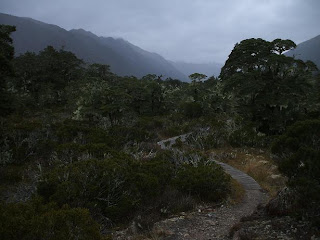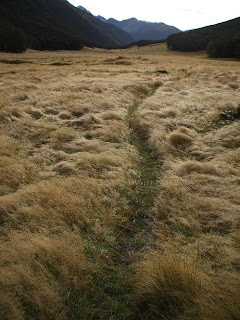
This past week, Stephen and I hiked the St. James Walkway. A popular tramp amongst kiwis, it is more common to find hunters and families along it than foreigners looking for their fill of New Zealand bush. Similar to most of the parks and tramps on the Southern island, the St. James walkway travels through several cattle and sheep stations, and therefore has no lack in megafauna encounters (though they tend not to be very charasmatic with all that poo lying in your path).
The walk starts at Lewis Pass, where a bus dropped us off at a tiny bus shelter on the side of the highway - gotta love the bus system here. There was a light drizzle, so that even at 11am when we started hiking, the sky was grey and gloomy. We tramped through a pretty dense forest, up Cannibal Gorge to Cannibal Hut and on to Ada Pass Hut. Along the way travelling across avalanch paths, alo

ng steep slopes, and towards the end, through some quite nice alpine meadows. Arriving at Ada Pass Hut was nice though, where we shared the place with three other groups - one couple out hunting deer, one couple doing the same thing we were, and a teacher and student from the NOLS New Zealand 'adventure' waiting on their team members to come over the pass. Stephen went to bed early as he was full on into a strep throat battle, but I stayed up and chatted with the others until a very late 8:30pm when we all decided to conserve the one candle we had and go to bed.
The next day, without tent or wet gear to deal with, Stephen and I were out of the hut in an astonishing

half hour. Even more astonishing was the fact that we were on the trail at 8am, that's earlier than I'm usually out of bed at home. But today was a long day, as we were going past the next hut and onto the following one, an agonising 20km hike through grazing land for cattle and apparently lots of Canada geese. We were lucky enough to spot 3 wild boars along the way, along with the plethora of song birds that live here, especially the Bellbird (http://www.nzbirds.com/birds/sound/bellbird2.wav). The Anne River Hut was our final destination for that night and proved every bit as nice as the Ada Pass Hut, although it was empty all but us. The hut system here in New Zealand is amazing. I mean imagine all the extra food we were able to bring without having to carry a tent (the answer is too much - though we had fresh fruit and veg the entire time).
The third day, the w

alk goes up another river valley to Anne Saddle and down into the Boyle River valley. Probably the most diverse in landscapes, this day was also sunny and warm. We spent the 6 hours from hut to hut dodging cow paddies, watching birds, finding mushrooms, and eating all our lovely fresh food. We got to Boyle Flats Hut at around 2pm with lots of light left in the day and plenty of books to read (what else do you do with free tent space?). So after soaking our feet in the river, reading the various magazines left by previous visitors, we settled into making dinner and enjoying ou

r last night in the bush.
The last day was a quick hike down to Boyle Village, with really only one stop to enjoy the show put on by a little male Fantail (http://www.youtube.com/watch?v=A3-KtEu0Tf4&feature=related). He was quite forward, almost landing on my head a couple of times. But we had a bus to catch and so continued on. At 2pm, the bus picked us up 15km south of where it had dropped us off along the highway and we were on our way home again, both wishing it could have been longer. We're already planning our next tramp, either Banks Peninsula or Harper Pass, depending on the weather. . . . .